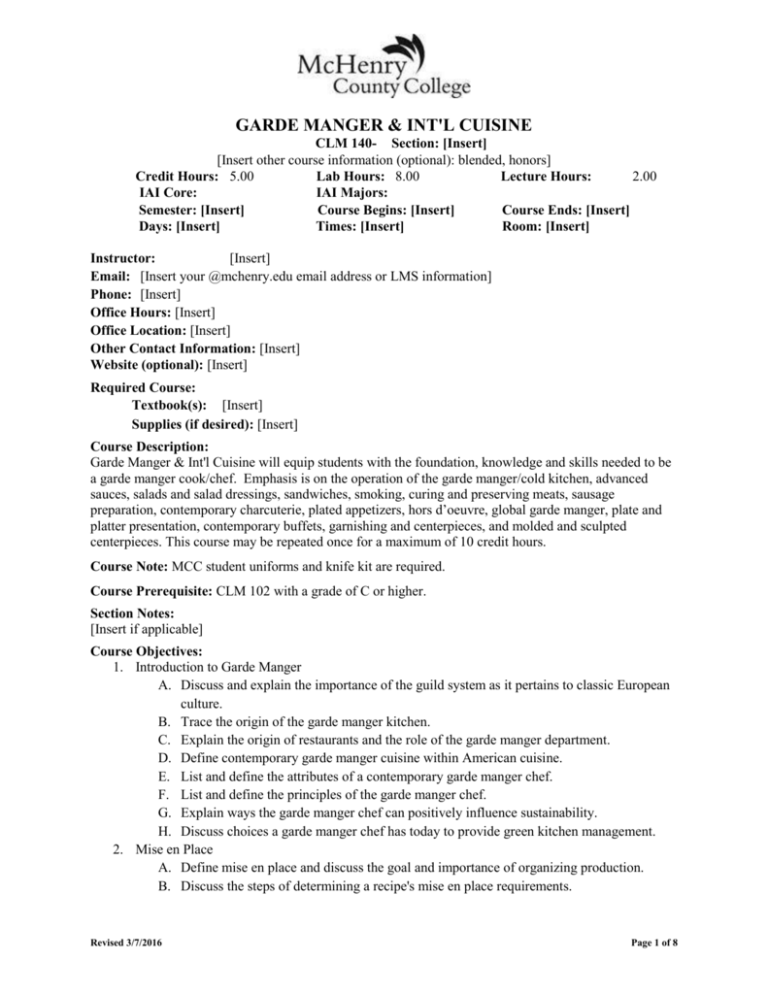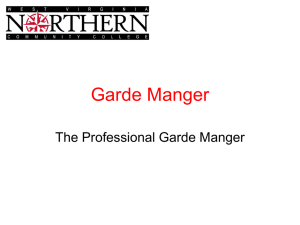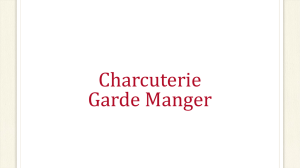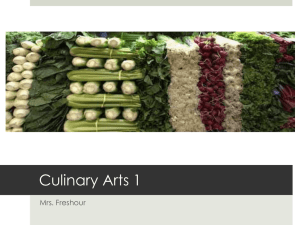GARDE MANGER & INT'L CUISINE CLM 140
advertisement

GARDE MANGER & INT'L CUISINE
CLM 140- Section: [Insert]
[Insert other course information (optional): blended, honors]
Credit Hours: 5.00
Lab Hours: 8.00
Lecture Hours:
2.00
IAI Core:
IAI Majors:
Semester: [Insert]
Course Begins: [Insert]
Course Ends: [Insert]
Days: [Insert]
Times: [Insert]
Room: [Insert]
Instructor:
[Insert]
Email: [Insert your @mchenry.edu email address or LMS information]
Phone: [Insert]
Office Hours: [Insert]
Office Location: [Insert]
Other Contact Information: [Insert]
Website (optional): [Insert]
Required Course:
Textbook(s): [Insert]
Supplies (if desired): [Insert]
Course Description:
Garde Manger & Int'l Cuisine will equip students with the foundation, knowledge and skills needed to be
a garde manger cook/chef. Emphasis is on the operation of the garde manger/cold kitchen, advanced
sauces, salads and salad dressings, sandwiches, smoking, curing and preserving meats, sausage
preparation, contemporary charcuterie, plated appetizers, hors d’oeuvre, global garde manger, plate and
platter presentation, contemporary buffets, garnishing and centerpieces, and molded and sculpted
centerpieces. This course may be repeated once for a maximum of 10 credit hours.
Course Note: MCC student uniforms and knife kit are required.
Course Prerequisite: CLM 102 with a grade of C or higher.
Section Notes:
[Insert if applicable]
Course Objectives:
1. Introduction to Garde Manger
A. Discuss and explain the importance of the guild system as it pertains to classic European
culture.
B. Trace the origin of the garde manger kitchen.
C. Explain the origin of restaurants and the role of the garde manger department.
D. Define contemporary garde manger cuisine within American cuisine.
E. List and define the attributes of a contemporary garde manger chef.
F. List and define the principles of the garde manger chef.
G. Explain ways the garde manger chef can positively influence sustainability.
H. Discuss choices a garde manger chef has today to provide green kitchen management.
2. Mise en Place
A. Define mise en place and discuss the goal and importance of organizing production.
B. Discuss the steps of determining a recipe's mise en place requirements.
Revised 3/7/2016
Page 1 of 8
3.
4.
5.
6.
7.
C. Properly perform essential cleaning and fabrication tasks associated with various fruits
and vegetables.
D. Establish, arrange and use a standard breading procedure for dry-coated and battered
food.
Sauces, Salad Dressings, and Condiments
A. Explain the functions of sauces and list the professional standards of quality by which
sauces are evaluated.
B. Prepare multiple sauces from standard sauce-making techniques.
C. Prepare miscellaneous hot and cold sauces for use in garde manger cuisine.
D. Explain how garde manger sauces differ from the sauces in savory cookery.
E. Identify and classify dairy-based sauces, salsas, coulis, purees, and miscellaneous sauces.
Salads
A. Recognize and discuss the place of salad in culinary history.
B. Identify and discuss various salad types and styles of service for salads.
C. Identify and discuss the functions of the four basic components of a salad.
D. Describe how to care for salad greens.
E. Identify, discuss, and mise en place various salad ingredients
F. Formulate a description of composed salads.
Sandwiches
A. Define various types of sandwiches.
B. Identify and explain the function of basic sandwich components.
C. Identify appropriate breads, spreads, fillings, and garnishes for sandwiches.
D. Recognize and demonstrate the appropriate presentation style of sandwiches.
E. Properly mise en place, assemble, and organize a sandwich station.
F. Demonstrate an understanding of the effects that sandwiches can have on the efficiency
of an operation.
Smoking, Curing and Preserving
A. Comprehend the purpose of cured and smoked foods and their place in culinary history.
B. Begin to identify the crucial ingredients for preserving foods and understand why they
are crucial.
C. Explain the function of salt in osmosis, dehydration, and fermentation.
D. Understand the various methods of food preservation.
E. Discuss seasoning and flavoring options for cured and smoked foods.
F. Examine the effects of dry cures and brines on foods and evaluate their worth in the
kitchen.
G. Describe the evolution of brining from a preservation technique to a flavoring technique.
H. Describe the method of preservation in fat and its importance in culinary history.
Sausages
A. Understand the role of sausages in culinary history.
B. Identify and use basic equipment associated with fresh sausage making.
C. Identify the necessary ingredients for sausages.
D. Discuss basic preparation of fresh sausage.
Revised 3/7/2016
Page 2 of 8
8.
9.
10.
11.
12.
E. Demonstrate a knowledge and understanding of the various standards of quality
associated with fresh sausage products and their preparation.
F. Demonstrate fundamental skills associated with fresh sausage making using the basic and
emulsified grinding techniques.
G. Demonstrate knowledge and understanding of the variety of cooking methods associated
with fresh sausage.
Contemporary Charcuterie
A. Understand the role of charcuterie in modern food service operations.
B. Identify various types of forcemeats including straight, country-style, gratin, and
mousseline.
C. Describe the procedure for making terrines.
D. Discuss why sanitation, equipment maintenance, and temperature play such a vital role in
the production of charcuterie items.
E. Explain the process of making galantines and roulades.
F. Recognize proper methods of working with foie gras including grading, cleaning, and
marinating.
Plated Appetizers and Hors d'oeuvre
A. Compare and contrast appetizers and hors d'oeuvre.
B. Identify various hot and cold plated appetizers, and hors d'oeuvre.
C. Discuss the role of appetizers in a la carte, buffet, and tasting menu situations.
D. Explain how to select and prepare appetizers.
E. Create a limited-selection hors d'oeuvre menu for a function.
F. Classify types of caviar and its role in garde manger.
Cheese
A. Trace a brief culinary history of cheese.
B. Describe the basic categories of cheeses.
C. Explain the cheese-making process overall.
D. Identify the classifications of cheese.
E. Research opportunities to purchase cheese products from local farmers.
F. Discuss cheese service and storage.
G. Describe the cheese-making process in the kitchen for fresh cheese.
The Global Garde Manger
A. Compare and contrast garde manger-style foods and the influences and characteristics of
various cultures.
B. Produce dishes based on the recipes provided.
C. Discuss the influences of these recipes on the student's personal style of cooking.
Principles of Plate and Platter Presentation
A. Discuss the importance of visual appearance as it pertains to buffet, banquet, and a la
carte settings.
B. Describe the role that color, contrast, balance, symmetry, height, shape, and layout have
in the presentation of food.
C. Design a dish that maximizes the factors that affect a plate or platter's visual appeal.
Revised 3/7/2016
Page 3 of 8
D. Recommend strategies to change poor presentations of food into ones that engage and
interact with the diner.
13. Contemporary Buffets
A. Understand the planning, design, production, presentation, and service of buffets and
platters.
B. Recognize the importance of concepts and themes.
C. Explain how to plan a buffet menu.
D. Discuss how to meet and exceed guest expectation.
E. Demonstrate the concepts of buffet maintenance, restocking, and service.
F. Explain the role of action stations in a buffet, including raw bars, pasta stations, and
omelet stations.
G. Understand how to enhance food presentation.
H. Understand and discuss the importance of presentation in large-quantity food service.
14. Garnishing and Centerpieces
A. Experiment with techniques to produce food art.
B. Learn basic garnishes in classical cuisine.
C. Analyze and contrast contemporary garnishing.
D. Understand the different needs in plate versus platter garnishes.
E. Name and describe elements of decorative centerpieces.
Course Outline:
I.
An Introduction to Garde Manger
A. The Guild System.
B. The French Revolution.
C. Famous chefs.
D. Modern garde manger.
E. Influences of modern garde manger.
F. Profile of a modern garde manger chef.
G. Influence modern garde manger has on sustainability and green kitchen management.
II.
Mise en Place
A. Defining mise en place.
B. Stages of production.
C. Standardized recipes.
D. Equipment of garde manger work.
E. Standard professional knife cuts.
F. Decorative cuts.
III.
Sauces, Salad Dressings & Condiments
A. What a cold sauce can do.
B. Sauce components.
C. Standards of quality.
D. Categories of sauces.
E. Emulsions.
F. Salad dressings.
Revised 3/7/2016
Page 4 of 8
IV.
V.
VI.
VII.
VIII.
IX.
G. Condiments.
H. Coulis and purees.
Salads
A. Salad components.
B. Common types of salad.
C. Salad station setup.
D. Styles of service for salads.
Sandwiches
A. What is a sandwich?
B. Types of sandwiches.
C. Sandwich components.
D. Sandwich station setup.
E. Properly presented sandwiches.
Smoking, Curing & Preserving
A. Food preservation.
B. What is food preservation?
C. Preservation ingredients.
D. Salt curing and smoking.
E. Smoking as a means of preservation.
F. Types of smoke.
G. Preservation by dehydration.
H. Pickling.
I. Alcohol preservation.
Sausages
A. Sausage making.
B. What is sausage.
C. Types of sausage.
D. Sausage components.
E. Curing agents.
F. Casing types.
G. The importance of sanitation.
Contemporary Charcuterie
A. Classical charcuterie.
B. Contemporary charcuterie.
C. Common charcuterie preparations.
D. Terrines and galantines.
E. Pate en croute.
F. Quenelles and roulades.
G. Importance of sanitation.
H. Nutritional values.
Amuse Bouche, Plated Appetizers & Hors d' oeuvres
A. First impressions.
B. Hors d'oeuvres.
Revised 3/7/2016
Page 5 of 8
X.
XI.
XII.
XIII.
XIV.
C. Amuse bouche.
D. Plated appetizers.
E. Caviar.
F. Canapés, tea sandwiches, and crudités.
G. Wrapped and filled hor d'oeuvres.
H. Kebabs, satay and brochettes.
Cheese
A. Cheese history.
B. What is cheese?
C. Cheese making process.
D. Locally produced cheese
E. Classifications of cheese.
F. Storing and serving cheese.
The Global Garde Manger
A. A worldly approach to garde manger.
B. Global influences.
C. Garde Manger in Japan, China, France, Italy, and Spain.
D. Global garde manger recipe preparations.
Principles of Plate and Platter Presentation
A. Food as art.
B. Elements of plate and platter design.
C. Color, contrast, balance, symmetry, height, shape, and layout.
D. Center of plate focus.
E. General guidelines for presenting food.
Contemporary Buffet
A. What is a buffet?
B. Three phases of contemporary buffets.
i. How themes can unify a buffet and efficiently communicate the desired outcome
of an event.
C. Discuss the motives and rationales for buffet service.
Garnishing and Centerpieces
A. Food art.
B. Garnishes in classical cuisine.
C. Contemporary garnishing.
D. Plate versus platter garnishes.
E. Elements of decorative centerpieces.
Assignments and Grading Criteria
[Insert. Must include the value of each project, skill, exam, etc. as it relates to the final grade.]
Policies
Revised 3/7/2016
Page 6 of 8
Attendance policy: Attendance is a mandatory expectation of this program. If a student will be late or
absent, they are expected to contact the instructor just as they would for a job. A student may be
withdrawn at ANY time, at the discretion of the instructor for excessive tardiness or absences. Excessive
is defined as:
2 tardies = 1 absence
3 non-consecutive absences = drop of one full letter grade
3 consecutive or 5 non-consecutive absences = student may be withdrawn
Late work/make-up policy: [Insert]
Weekly Course Schedule
[Insert date of each class meeting, topics to be covered, assignment due dates, testing dates, final exam
date, etc. Table format below is optional.]
Dates of
Class
Meetings
Week #1
Week #2
Week #3
Week #4
Week #5
Week #6
Week #7
Week #8
Week #9
Week #10
Week #11
Week #12
Week #13
Week #14
Week #15
Week #16
Course Schedule
{Tentative Activity}
{Tentative Activity}
{Tentative Activity}
{Tentative Activity}
{Tentative Activity}
{Tentative Activity}
{Tentative Activity}
{Tentative Activity}
{Tentative Activity}
{Tentative Activity}
{Tentative Activity}
{Tentative Activity}
{Tentative Activity}
{Tentative Activity}
{Tentative Activity}
{Tentative Activity}
Teaching Schedule
The scheduling of the activities and teaching strategies on this syllabus, but not the objectives or content,
may be altered at any time at the discretion of the instructor.
Withdrawals: The last day to drop this course is [Insert date according to Important Class Dates for term
https://catalog.mchenry.edu/syllabi/Pages/default.aspx]. Failure to attend class does not constitute official
withdrawal. If students are considering a withdrawal, they should consult directly with the instructor and an
academic advisor. Students may withdraw from a class through the Registration Office, either in person or by
Revised 3/7/2016
Page 7 of 8
fax: (815) 455-3766. In their request, students should include their name, student ID number, course prefix,
number and section, course title, instructor, reason for withdrawing, and their signature. Withdrawal from a
course will not be accepted over the telephone.
Academic Support for Special Populations Students
Students with Disabilities:
It is the policy and practice of McHenry County College to create inclusive learning environments. If you
are a student with a disability that qualifies under the American with Disabilities Act – Amended
(ADAA) and require accommodations, please contact the Access and Disability Services office for
information on appropriate policies and procedures for receiving accommodations and support.
Disabilities covered by ADAA may include learning, psychiatric, and physical disabilities, or chronic
health disorders. Students should contact the Access and Disability Services office if they are not certain
whether a medical condition/disability qualifies. To receive accommodations, students must make a
formal request and must supply documentation from a qualified professional to support that request.
However, you do not need to have your documentation in hand for our first meeting. Students who
believe they qualify must contact the Access and Disability Services office to begin the accommodation
process. All discussions remain confidential. The Access and Disability Services office is located in
Room A260 in A Building in the Atrium. To schedule an appointment to speak with the manager, please
call (815) 455-8766. Information about disabilities services at MCC can be found at:
www.mchenry.edu/access
Students in Career/Technical Programs
As a student enrolled in a career or technical education program at McHenry County College, you may be
eligible for services and assistance under the Carl D. Perkins III Grant. Grant funds are used, in part, to
assist students who are at risk of not succeeding in their educational pursuits. The traits that often prevent
students from succeeding are: economic disadvantage, academic disadvantage, disability/disabilities,
single parent, displaced homemaker, enrollment in a program in which their gender is under represented,
and limited English proficiency (LEP). The definitions of each trait are available in the Access and
Disability Services office. Students with one or more of these traits are referred to as Perkins Special
Populations Students.
If you would like to know if you are eligible for services at any time during the semester, please do not
hesitate to contact the Manager, Access and Disability Services. The office is Room A260, and phone
number is (815) 455-8676.
Additional syllabus information and resources can be found at www.mchenry.edu/syllabusinfo.
STUDENTS ARE RESPONSIBLE FOR KNOWING ALL SYLLABUS INFORMATION.
Revised 3/7/2016
Page 8 of 8





